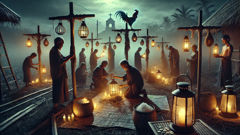Introduction
When night lands on the rice terraces and the last sari-sari store light clicks off, the countryside seems to inhale: a long, patient breath that lifts the hair at the nape of your neck. In the Visayan islands and in scattered pockets of Luzon and Mindanao, that silence is not empty; an old name rides it. People say it quietly at the edge of memory—pugot—and the word is a cord pulled taut between laughter and a sudden, sensible fear. The Pugot is a headless spirit that moves faster than a running man and takes forms that confuse the eye. It may appear as a stray dog rushing past a fence, a child dashing through talahib, or a shadow hunched beneath a niaog tree. Then the headless thing will surge: a patch of torn shirt, a neck like a broken stump, or sometimes a living head rolling across a dirt road and calling your name. Stories insist it delights in terror, but the old women who sweep yards at dawn will tell you of its reasons—with different emphases: retribution, hunger, a vow never honored, or a curse born of some violent act long ago. Each telling is a brushstroke on the same dark canvas.
This account gathers origins, eyewitness accounts, ritual responses, and the changing shape of belief. It is not a catalog of confirmed facts; it is a lyrical, investigative homage to a creature that refuses to stay in one place. Here you will find a map of the Pugot’s presence across islands, the ways communities try to bind or confuse it, and how modern life—scooters, neon streetlamps, late-night radio—has altered encounters. You will read of people who met it and survived, of those who did not, and of the small, stubborn rites that persist because they keep families together. The Pugot is a folklore monster, yes, but it is also a kind of social thermometer: where the Pugot returns most often, trust has frayed and silence has stretched into secrets. If you walk these pages at dusk, leave a little light burning. The stories ask you to listen carefully, to respect the older grammar of place, and to hold both dread and compassion at once. Stories don’t only scare; they teach us how to notice the gaps between one life and the next.
Origins, Forms, and Early Tales
Across the Philippine archipelago, origin stories of the Pugot vary in detail but share the same anatomical shock: a torso that carries no head and yet somehow commands motion, voice, and malice. Some elders point to pre-Christian myths of wandering spirits punished by gods for arrogance or theft. Others trace specific lineages: a man decapitated in a quarrel whose head was lost to the river; a woman who bargained with a diwata and paid with the wrong coin; a war-time atrocity that left families with bodies unburied. These threads knot together in village retellings and become the folklore we recognize. Each telling carries a moral itch, a reason why right must be made with wrong, or why the living must attend to the dead.

One canonical form of the Pugot is purely elemental: a neck stump that drips moonlight, blackened with soil and leaves. In another common account the Pugot is a roving head—sometimes decapitated, sometimes intact—bounding ahead of its body. That head can speak, beg, or mimic the voice of a beloved, calling to lure a passerby from safety. Yet other stories say the Pugot is fully faceless beneath a cloth or within a shapeless mass, and it borrows the shape of animals—dogs, pigs, chickens—or even people to deceive. When it moves, there is often a smell mentioned: damp earth, old blood, or the metallic tang of rust. That sensory detail is a favorite of narrators because smell ties memory to place; people recall where they were by what the air tasted like when the Pugot passed.
The earliest written record of a headless apparition in Philippine colonial chronicles might not use the word pugot, but Spanish friars and local scribes noted “a headless wretch” seen near swampy places. Filipino storytellers absorbed those notices and made them their own, interlacing pre-colonial ideas of spirits with Christian notions of punishment and sin. In the Visayas, the Pugot is often said to be born from an unavenged crime: a man who killed his kin, a woman whose wedding vow was broken, a child whose name was stolen. The Pugot returns seeking redress or merely to unsettle the living who have forgotten proper rites. Rituals developed accordingly. If a corpse’s head was lost, neighbors might fashion a substitute and bury it with prayers. If a person died unjustly, villages sometimes perform extended wakes and invite community leaders to speak names aloud, because naming binds and naming heals. Through these same rituals, communities show the Pugot where its story belongs.
A recurrent motif in origin stories is speed—the Pugot runs and it runs like wind. Witnesses say it can move down a road at a pace that confuses the eyes, blurring into the roadside trees and reappearing as if it had simply taken the stretch of earth and changed it. This unnatural swiftness distinguishes the Pugot from slower-depending spirits. It is not the slow, pathetic phantom of regret; it is kinetic and urgent. This urgency carries a narrative force: the Pugot’s anger or hunger is a force of weather, arriving without warning and departing with the same abruptness. That quality makes it both a perfect terror for late-night travelers and a morale lesson: in a community, neglect yields rapid consequences.
In some places, the Pugot is deeply territorial. Farmers will tell you where—precisely—it is said to appear: a bend in the path where a banyan tree roots into cracked earth, a culvert beneath a road where fog collects, a patch of talahib that shivers even during still moons. These names of place are how storytelling anchors the creature. A teller will say, “Do not pass the old puente when the lantern blows,” and that sentence acts like a tether between landscape and narrative. Children grow up being told the precise crossing to avoid. And even as roads are paved and barangay lights installed, the names persist, because memory clings to topography.
Modern retellings mingle with older ones. Motorbike headlights and mobile phone torches distort perception, and accounts now include the Pugot darting between cars or looming near barangay health centers. Radio DJs spin cautionary tales as night fillers. Social media threads collect sightings, strategy, and mockery. But migration and urbanization have also transformed the Pugot’s audience. Where a village once relied on elders to adjudicate whether a sighting was spirit or a trick of the light, urban communities file stories into comment sections. The Pugot survives this translation because its core is not the facts of sight but the story’s reason: that something in the community has been unsettled and refuses tranquil closure.
Through history, the Pugot has become a kind of barometer for what a community fears to say openly. In some retellings it punishes those who break promises to neighbors, who take more than they give, or who refuse to bury a family member properly. In others it is a warning about late-night wandering, a cautionary figure for children. The balance between supernatural explanation and social lesson is not delicate; it's purposeful. Folklore evolves not to explain the world in the scientist’s sense, but to hold people accountable to one another. The Pugot, in that measure, is less an anomaly to be cataloged than a living admonition shaped by the communities that named it.
(image placeholder)
Eyewitness testimonies are typically braided with rumor and private grief. The most consistent detail, beyond the lack of head, is the feeling people recount: time seems to change speed in the presence of the Pugot. A rural midwife once told me of walking home with a bundle of betel nut when she heard a child cry from the cane grass at the roadside. She called back and a voice—the voice of her late brother—answered. She stepped off the path toward the sound and only then realized the speaker’s mouth was not attached to any face. She ran, hearing footsteps that were too close for comfort and then suddenly far ahead. In the morning, she found her bundle untouched and a line of small prints in the mud leading into the darker parts of the field and disappearing. Other accounts describe hearing doors knock, whispering that imitates a wife’s voice, or a severed head rolling down the hill and shouting the name of the living. These stories, when collected, map the Pugot’s tactics: it imitates, it nags with familiar speech, it plays on grief.
Language matters. The word pugot is itself blunt and physical; in many Filipino tongues it means simply “headless.” To name the thing is to remove the poetic distance; the name becomes a tool for whispering warnings across porches in the early hours. Storytellers embellish, but the base word stays a taut fact: the creature lacks a head, and that absence carries meaning. Whether the Pugot represents unavenged blood, the ramshackle consequences of disrespect, or the natural world turned resentful, the naming makes communities ready for action. Because folklore is practical in its own way, it prescribes behavior: how to bury the dead, how to speak at wakes, and which paths to avoid when lanterns fail.
These early tales teach us that monsters are rarely only monsters. The Pugot is a social story first and a haunting second. Its forms and origins teach us about the places that tell its tales—their histories of violence, love, loss, and the rituals that stitch ordinary days into the safer fabric of communal life. As modernity complicates those fabrics, the Pugot’s stories adapt, but they always hold to their centers: place, memory, and the insistence that community must keep promises to the dead and the living alike.
Encounters, Wards, and Modern Meaning
Encounters with the Pugot are often described with a surprising focus on small, practical details: the snap of a twig, the odd placement of a broom, the way the moon seems to go behind a cloud at the exact instant a voice calls from the road. Those who grew up in barangays where witchcraft and spirits were part of everyday concern learned early that preparedness is mundane—lock doors, set chickens inside, leave a light burning near the kitchen door—and that certain objects matter more than they should. A handful of common wards appears in almost every telling. Salt is a universal barrier; thrown at a figure it might sting its eyes, and a line of salt at a threshold can confuse a spirit’s movement. Mirrors and polished metal are used to catch and dazzle; sometimes a reflection will cause the Pugot to hesitate, giving a person time to flee. Garlic and betel leaves, though less often mentioned for Pugot than for other spirits, appear in a few north-of-Luzon accounts. And there are insistences that the head must be named aloud at a funeral because a named dead may not wander into living rooms.

Villagers have other more creative strategies as well. Some communities braid rooster feathers into a bundle and place it under the house post to make the ground feel occupied and familiar to spirits. Old women often tie a small cloth bundle containing rice and a coin to the eaves, a humble offering that suggests continuity rather than hunger. Children are taught to call out the names of their kin if a voice answers their own—an act that tends to break the imitation and expose the trick. When a Pugot insistently haunts a stretch of road, elders may stage a mock celebration—a feast with loud music and many guests—to confuse and shame the spirit into leaving. These practices are less about superstition for its own sake than about reminding the living that social bonds are stronger than cunning solitude.
Witness accounts recorded during fieldwork show that timing is central. The Pugot likes the hours when people are most alone: the thin slice of night between midnight and dawn when a lone rider on a motorcycle will be tempted to pull off the road into a narrow lane. In such hours the Pugot acts like a magnet for memory and misrecognition. A commuter who glances at a roadside figure expecting a human silhouette is more likely to misread motion; the Pugot exploits this. Equally, the creature's speed makes it difficult to photograph. Many modern posts that claim captures are either grainy blur or misinterpretations of animals caught mid-leap. Urban legends spin these images into viral stories that feed themselves: each new report becomes both validation and stylistic addition to the Pugot’s repertoire.
There are, however, stories of survival that are detailed and consistent enough to merit attention. A tricycle driver in Samar described a night when his headlights revealed a headless form crouched at the side of the road. He slowed, prepared to offer a lift—villagers often do that—and the thing spoke in a voice like his dead cousin asking for a ride. The driver refused and remembered his father's rule: do not take the dead to the living place. He kept the light on, drove straight past without turning the wheel, and an unnatural wind hit the back of his neck. For three nights after, scratches appeared on the tricycle seat as if someone had been trying to claw at it. He began leaving salt in a small bowl on the dashboard. When the village shaman came to inspect, he said the Pugot had been denied and would move on.
Folklorists note a pattern: when neighbors perform communal rituals—shared meals, wakes, or the simple act of naming the dead aloud—the Pugot’s appearances diminish. The creature appears more often in places where family ties have thinned: the elderly left alone in little houses, ghosts of quarrels unspoken, and property disputes that linger like sour fruit. This connection between social fragmentation and supernatural activity is key to understanding the Pugot’s modern meaning. It is a mirror held up to communities, reflecting where care has been withdrawn and where obligations have been neglected.
Modern public authorities have sometimes responded with practical measures that mix scientific rhetoric and cultural sensitivity. Barangay officials, when faced with a string of sightings that escalate into panic, might hire a vehicle to light the road at night or organize a community watch. Some mayoral offices have invited cultural workers to document practices and advise on preserving healthy communal rituals that ward off fear. Hospitals and clinics have found that education about sleep disturbance, hallucinations linked to exhaustion, and the effect of intoxicants can reduce panic; but clinical explanations seldom replace the comfort that ritual provides. People still want to grieve in the older ways when loss is sudden or violent. They value the symbolic closure that burying the dead properly offers.
Migration and modern media have not erased the Pugot; they have multiplied contexts. Overseas Filipinos share tales with relatives by phone, adding new layers—an American streetlight, a mall corridor—while older neighbors retell them with the same exacting details of earth and smell. Horror films borrow from the Pugot’s grammar—headless, swift, deceptive—but cinema also simplifies. The oral tradition resists that simplification. A storyteller in Bohol once told me she prefers the slow build of a whispered tale around a kerosene lamp. “Give them time to remember who they are,” she said. “If you scare them too fast, you take away the lesson.” That lesson, again, is not only how to avoid being devoured. It is about attending to one another.
Practical advice circulates with moral instruction. If you must travel a feared road at night, travel in numbers and keep a radio on. Leave a string of lighted lamps in the field when you must pass it; tell a neighbor where you’re going. At wakes, do not let the dead lie nameless. Fix small amends where promises were broken—pay owed wages, repair a roof, share food. These actions might sound like mundane social work, and in a way they are. They are ritualized responsibility. People who care for one another are less likely to become the prey of a Pugot because the creature’s power depends on isolation and unresolved grievance.
Finally, the Pugot lives as an ethical instrument as much as a supernatural one. Young people who scoff at elders’ warnings often find, during nights of crisis or personal grief, that there is a practical safety in the old rules: keep to the well-lit road, do not follow unfamiliar voices, and answer a crying child with naming. The Pugot’s endurance in the Filipino imagination reveals how folklore adapts to new dangers while preserving the wisdom of communal living. It is a story that asks to be told at dusk, not merely for fright, but to remind listeners that the nighttime world is not only dark but also bound by obligations that can be renewed with simple human acts.
Conclusion
The Pugot is not merely a creature of fright; it is a cultural mirror that forces us to look at how communities care for the dead and for each other. Whether you accept its existence on the axis of supernatural fact or regard it as a narrative tool, the Pugot’s persistence tells a story about human vulnerability and resilience. In the bend of a road where talahib shivers, in the old house where the lantern is left on, in the wake where names are spoken aloud, humanity practices a kind of repair. That practice matters. As long as people tell the story, light a lamp, and remember to speak names, the thing that thrives on neglect will be thwarted not only by salt and mirrors but by the steady, ordinary work of attention. Old tales keep us awake for a reason: they are instructions, warnings, and companions all at once. If you walk by a shadowed field tonight and hear a voice you once loved, stop and listen with caution, call the right name, and, if you can, bring a neighbor with you. The Pugot’s legend will remain a part of Philippine folklore because it asks for more than fear; it asks for repair.













